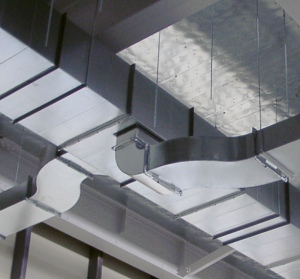It's not funny how much conditioned air you may be losing in the duct system in your house. Once you've addressed the Floors, Walls, and Ceilings of your home for weaknesses, move on to your HVAC Ducts. If you don't already know, this is the system of pipes or tubes made of sheet metal, fiberglass, and other materials that manages airflow through a building. Ideally, a home's HVAC Duct system evenly distributes air from the furnace and central air conditioner to every room of the house creating a neutral pressure zone at a comfortable temperature. Most homes don't meet this ideal. Instead there are weaknesses in the system. A basement that never gets enough heat. A bedroom that never cools down in the summer. Quite often duct system designs are poorly conceived or installed.
Sealing, insulating, clearing and upgrading. These are steps to take to redirect the conditioned airflow within your home. Because the system of ducts, registers and grilles goes through so much temperature fluctuation, each piece shrinks and swells, trying to adapt itself to the demands you place on it. Naturally this causes sections to separate, develop holes, fall apart, and need resealing. Some of the maintenance can be done by you, but the real duct work is always a job for professionals. Sealing and insulating are most pertinent for ducts in unconditioned spaces, like Attics, Basements, and Crawlspaces. If these exposed ducts are not insulated, hot and cold air that you pay to condition gets pushed out of unsealed connections and lost, continually, resulting in hundreds of dollars of unnecessary energy spending every year. The opposite is also true of return ducts; unconditioned air is pulled into your living spaces through similar weaknesses in the return system. For those homeowners looking to install new ducts, be sure that the new ones come with insulation. If you are a homeowner hunting for gaps in your existing system, keep an eye out for sections that have separated, and if you find a hole, tape it up with a heat-approved tape such as mastic, butyl, or foil tape. Ironically duct tape is less effective on ducts than it is on most other things.All of your ducts need to be cleared from time to time because all the dust and other air-born particles can settle and block airflow in low-pressure returns. Sometimes small objects fall into floor grilles which can add to inside accumulation. This build-up degrades the quality of the air in your home, which degrades your respiratory health. Something you can do to decrease dust accumulation and increase airflow is vacuum over the grilles in your home. Also avoid covering registers with furniture, carpets, and wall hangings. And if you have a habit of closing the doors in your house, try leaving them open to see how it affects airflow.
There are a number of upgrades that can be made to your home's HVAC Duct system, some simpler than others. But when supply ducts are thought to be an energy drain, first check problem areas for weaknesses that may be affecting temperature, such as weaknesses in insulation, air leaks, and windows for air-tightness. If you then determine the ducts are the problem, a final solution is adding new ducts or upgrading the size of existing ducts in your system. Simpler upgrades include adding return air grilles, undercutting doors (increasing the gap between the bottom of a door and the flooring or carpet beneath it), and creating jumper ducts. Jumper ducts connect adjacent rooms, allowing air to flow to the return ducts, which are generally centrally located on each floor, but are more effective when connected to every room. But don't take my word for it. Only a thorough inspection by a professional can determine what measures are necessary to improve your HVAC system.
When some homeowners make upgrades, modifications, renovations or extensions to other parts of their house, they neglect to consider how it will affect the HVAC system. The different supply duct configurations include spider, perimeter loop, radial, and trunk and branch. Of these configurations, the latter two are most appropriate for duct systems in conditioned spaces. If ducts are installed in the areas of the home being conditioned, they are less likely to leak or be affected by outside temperature. These ducts are hidden in dropped ceilings, walls, and raised floors. This makes them much more energy efficient than duct systems that have branches exposed to unconditioned areas.
For maximum efficiency, all HVAC Ducts must be sealed and insulated. And if all Floors, Walls, Ceilings and Fireplaces are sealed and insulated too, you will notice a dramatic difference in not only your comfort, but also when it comes time to pay the bills. For help identifying these problem areas and energy drains, schedule a Home Energy Audit with America's Best Energy Team. Their detailed analysis and thorough testing procedures will pinpoint where your home is losing energy. They will take you one step closer to the safety, comfort and home energy efficiency you require.
By Nick Ring.Tags
Subscribe to NV Roofing's Blog




